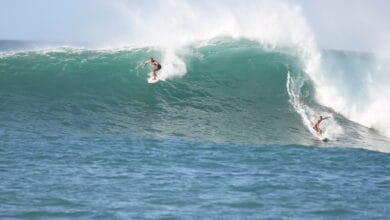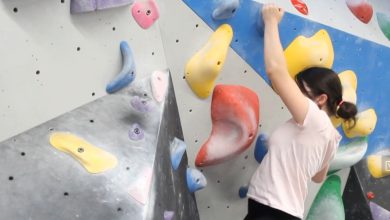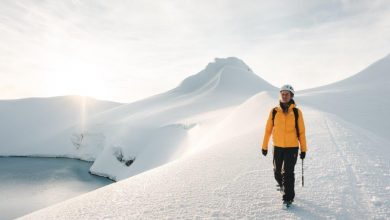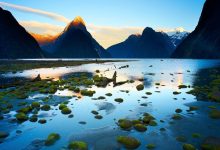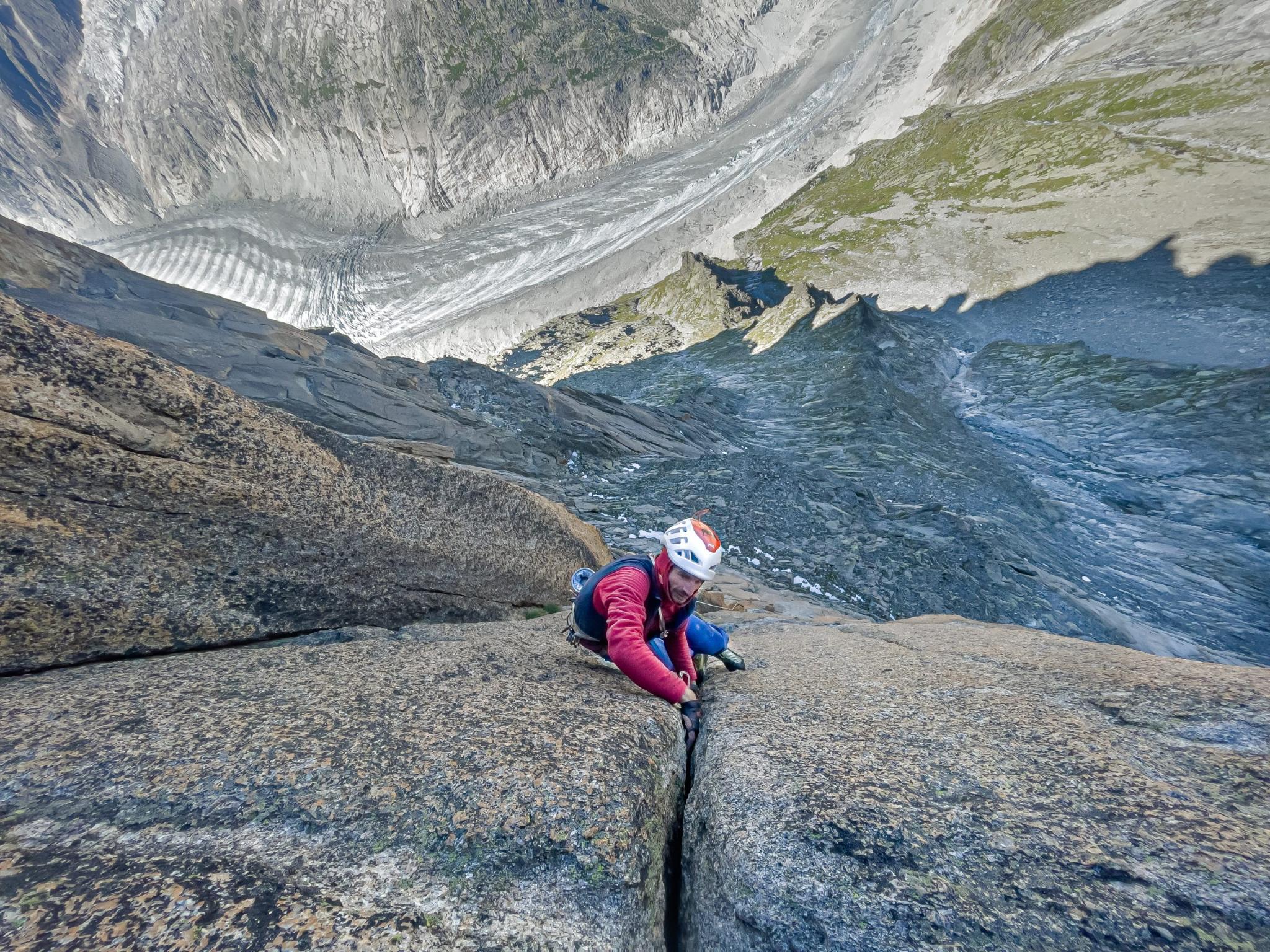
It sounded like an earthquake, but the ground below us was still. As if in slow motion, an increasingly thunderous noise drifted in from the other side of the valley, where blooming dust clouds signalled a rockfall of gargantuan proportions.
This is always a disconcerting sight for a climber. It was especially alarming because we watched the debris peter down towards a gully where we’d been planning to venture in the coming days. The gully was the access to 375m-long alpine climb called Sala Athee, on the peak known as The Monk, which was recommended to us because of its technical crack climbing.

We were sitting in an idyllic bivvy spot below the granite needles of Envers des Aiguilles, near Chamonix, in the heart of the European Alps. The rockfall wasn’t anywhere near us, but witnessing such a large one always focuses the mind on what might fall down at any moment.
All through the night, the unnerving sound of collapsing rocks echoed around us. If I happened to be awake, there was little to do but hide in my sleeping bag and hope we weren’t in the direct path of anything.
The following day, as we scaled the jagged corners and technical slabs of a 650m-high climb called Banana Republic, we remained on constant alert to the possibility of rockfall, which, thankfully, never eventuated.
We had chosen the climb because it had less objective danger than other routes in the Mont Blanc massif. The European summer had been a sweltering affair, and many of the glaciers in the alps were already opening up. In early July we had crossed the Valle Blanche to climb the magnificent granite tower, Grand Capucin, and were later told that a guide and his client had both fallen into a crevasse, breaking several bones, while crossing the same glacier at around the same time as we had.

A week before that, a serac the size of two football fields collapsed from the top of the Marmolada Glacier, in the Italian Dolomites, killing 10 people. It’s still unclear how it happened, but it wasn’t an area known to be dangerous, nor was it a hanging glacier, where icefall would be expected. But rising temperatures have made glaciers more unstable; leading up to the accident, a weather station at 3250m on the Marmolada had recorded 23 straight days of temperatures above 0 degrees Celsius.
These are uncertain times, as rising temperatures change the face of the mountains we love to play in. Over the last century, temperatures in the European Alps have gone up by 2 degrees Celsius, twice the global average. Climate change has contributed to glaciers shrinking by more than a third over the last 18 years. And while scientists expect the Marmolada to disappear altogether within 15 years, others predict all glaciers in Europe below 3500m will have gone by 2050.
The same pattern has been observed in New Zealand, which in general means the snowline is creeping higher while the volume of ice shrinks. Studies from the National Institute of Water and Atmospheric Research show that a third of the permanent snow and ice in the Southern Alps was lost between 1977 and 2014. More recently, New Zealand glaciers have been shown to have lost 1.5m a year from 2015 to 2019, almost seven times as much compared to the thinning that occurred between 2000 and 2004.
As a globe-trotting dirtbag climber for more than a decade, this poses a dilemma: how to offset the carbon footprint of someone who regularly undertakes long-haul flights and super-long drives. Some feel so guilty about their impact on the planet that they no longer indulge in visits to far-flung climbing destinations.

But giving up a lifestyle that has given me so much is too much of a sacrifice, personally. So I look for other ways to reduce my carbon footprint. A huge chunk of greenhouse gas emissions come from agriculture; in New Zealand, it’s almost 50 per cent. Red meat, in particular, leaves a large carbon footprint, due to cows’ methane emissions.
A recent American study found that if every person in the US cut their meat consumption by 25 per cent, annual greenhouse gas emissions would fall by 1 per cent. So rule number one is ‘eat less meat’ or, more particularly, ‘buy less meat’; I have no problem eating a steak that someone else won’t eat, for example, because it doesn’t contribute to consumer demand.
Which brings me to the second rule: about a third of all food produced is thrown out. This is not only offensively wasteful, but it also scars the environment, given how much energy and water it takes to grow, harvest, package and distribute those billions of tonnes of food.
Rule number two is ‘no waste’, and it doesn’t just apply to my food. Those who partake in the dirtbag lifestyle are familiar with eating the leftovers on someone else’s plate in a cafe or restaurant, or dumpster-diving, where the all-important smell-test determines what might still be edible.
Nor does it apply to only food. The holes in my climbing clothing are generally covered in duct tape, and I only ever acquire clothing – usually second-hand – when my old ones are well and truly beyond their retirement date.
And when I travel, I tend to go for a long period on a one-way ticket, rather than take several flights a year for a number of shorter climbing holidays. When not travelling, I have a further rule: unless the weather is apocalyptic, I don’t tend to drive, and if we do drive to climbing crags, we car-pool.

Personal actions, of course, are insignificant in the grand scheme of things unless they are done collectively. These are all easy ways everyone can reduce their carbon footprint.
But climate change is already happening to such an extent that it is irreversible. For alpine climbers, the seasons are already no longer what they used to be. Warmer climes mean thinner and vanishing snow bridges over glacier crevasses, ever-wider bergschrund gaps between the ice and the rockwall, and melting permafrost releasing clumps of rock and soil that are normally frozen together.
The latter is thought to be behind the fate of the hut known as the Bivouac de la Fourche, which was perched precariously on the Kuffner Ridge on Mont Maudit, but which collapsed into the Brenva Glacier in August. There was no cliff above it that could have unleashed a hut-smashing rock-slide.
And then there’s glacial retreat, which makes some climbs inaccessible due to an increasingly hostile moraine wall to overcome. Even if you do make it, there might be an extra 25m of technical climbing just to reach what used to be the start of the route.
I had arrived in France at the end of June, and quickly jumped on some ice climbing objectives before the summer temperatures made them unclimbable. The top section of the classic Frendo Spur, on Aiguille du Midi, had already deteriorated to black glacial ice instead of much friendlier snow névé, which had already melted.
Within two weeks, the unofficial advice was not to climb on certain mountains because getting there was too dangerous. Crossing some glaciers had become a lottery, we were told, rather than an exercise in skill and knowledge. And attempting some routes was tempting fate: a huge boulder on Cosmiques Arête fell down a few weeks after we’d climbed it.
As rockfall became more and more ubiquitous, Chamonix-based climbers looked to objectives that didn’t involve crossing a glacier. The Sala Athee, in the Charpoua area, was one such climb, but we were hesitant after having watched a massive avalanche sweep down towards the gully that leads to it.
We decided to head up to the area anyway and seek the local advice of the guardian at the Charpoua Refuge, who told us that there hadn’t been any activity in the gully since then. Several parties had also climbed the route in the previous week, including the previous day.
The next morning, pre-dawn, was a still, chilly atmosphere as we approached the gully. It was slabby and slippery, as expected, given it had been glacially-carved eons ago. Rockfall was thankfully absent as we scrambled up to the base of the climb.
Sala Athee starts with two warm-up pitches before the wall steepens into a technical slab, an awkward chimney, and then a series of splitter cracks that climax in an exposed step around an overhanging arête. The top-out, too, is suitably glorious: a flat, wide and spacious platform that wing-suiters, in the right conditions, would happily launch from.
Nerves around the descent were always going to centre around down-climbing the gully. A mountain is generally a lot more unstable in the evening, after its features have spent several hours in the warmth of the day. We did what all alpinists do when confronted with unavoidable objective hazards: we crossed our fingers and hurried through.
It seemed a fitting metaphor in these warming times. There will be a time in the not-too-distant future when classic routes are no longer what they were, or may have even fallen down altogether. For those that are still there and are safe enough to climb, there’s no time to waste.
–Words and photos by Derek Cheng
www.instagram.com/dirtbagdispatches




